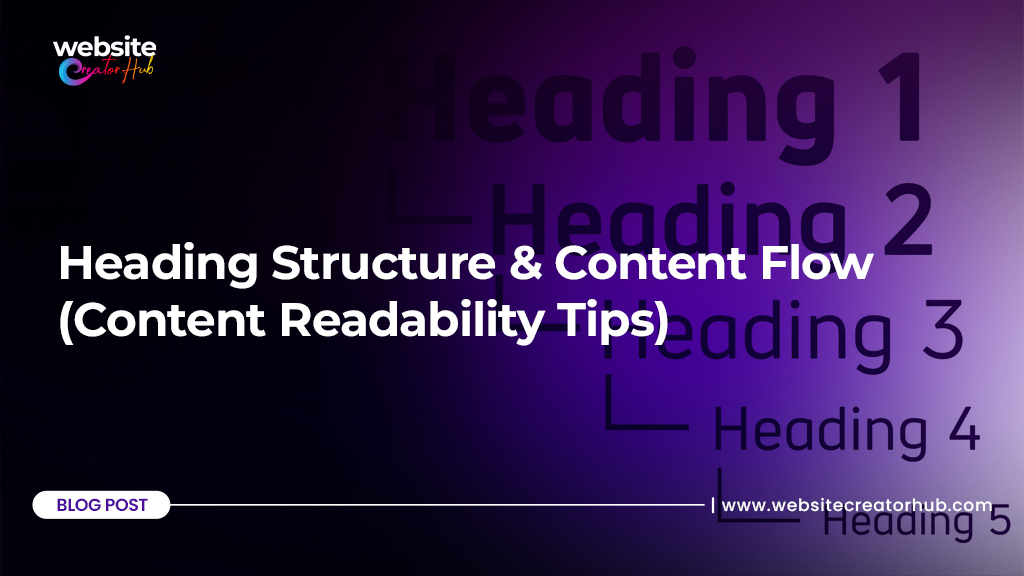In the digital world of todays, first impressions are made within seconds. When a user lands on your website, the clarity of your content presentation determines whether they stay or bounce. Heading structure and content flow are often underestimated aspects of content creation, yet they play a pivotal role in capturing user attention and ensuring readability. For businesses aiming to thrive online, especially in competitive markets like the USA, mastering these elements is non-negotiable. Website Creator Hub guides brands to create content that also reads naturally. Moreover, this blog provides actionable content readability tips anchored in strategic heading structure and smooth content flow.
Why Heading Structure Matters for SEO and UX
A well-planned heading structure is more than just visual hierarchy—it’s an SEO powerhouse and a roadmap for user navigation. Search engines like Google use headings to understand the content hierarchy and relevance of a page. From an SEO perspective, proper use of H1 to H6 tags helps organize content in a way that boosts indexing and relevance. From a user experience (UX) angle, a clear heading structure allows readers to scan content quickly and find what they’re looking for without friction. In short, the structure benefits both bots and humans, which is a key tenet of SEO best practices for website ranking USA.
Crafting the Perfect H1: Your Page’s Mission Statement

The H1 heading is typically the first thing a user sees and serves as the primary topic of the page. It should be clear, concise, and contain the main keyword. For instance, if your target keyword is “Content Readability Tips,” an ideal H1 might be: “Essential Content Readability Guidelines for Modern Websites.” Avoid stuffing it with keywords. Instead, ensure it communicates value and sets expectations. The H1 should only appear once per page to maintain structural integrity and provide a single focal point for both search engines and readers.
The Role of Subheadings: H2, H3, and Beyond

Subheadings such as H2 and H3 play the role of organizing content into logical sections. Each H2 should introduce a new section that supports the H1 topic. H3s can then be used to break down the content under H2s further. This cascading structure allows for intuitive navigation and improves dwell time—a key ranking signal. Using relevant keywords in subheadings where appropriate (without over-optimization) can improve topical authority. This aligns with SEO heading structure best practices, enabling both better crawling by bots and better comprehension by readers.
How to Plan a Logical Content Flow
Beyond headings, the arrangement of your content must follow a logical flow. Think of each section as a building block that leads to the next. Start with an introduction that outlines the problem or context, move into a middle section that provides solutions or insights, and end with a conclusion or call to action. This progression is not just reader-friendly but algorithm-friendly too. Therefore, search engines reward clarity and organization because they make content easier to understand and more engaging.
Keeping Paragraphs Short and Focused
When it comes to content readability tips, paragraph length matters. Dense blocks of text are intimidating and hard to read, especially on mobile devices. Ideally, keep paragraphs between 2 to 4 sentences. Each paragraph should present a single idea or point. This structure improves comprehension and keeps readers scrolling. Also, consider visual breaks such as bullet points, bolded text, and white space to aid skimming and retention.
Transitions and Connectors: Enhancing Flow
Transition words and connectors guide the reader from one idea to the next. Terms like “however,” “in addition,” and “consequently” establish logical relationships between thoughts. This not only enhances flow but also strengthens the coherence of your message. Readers appreciate content that feels like a guided journey rather than a scattered set of ideas. So, it’s a subtle but powerful tactic to boost user satisfaction and engagement metrics, both of which affect rankings.
Using Lists and Bullet Points for Clarity
Lists and bullet points break down information into digestible pieces. They are especially useful when presenting steps, features, or benefits. From an SEO standpoint, properly structured lists can lead to featured snippets in search results, improving visibility. They also make content easier to scan, particularly on mobile. Incorporating these elements as part of content readability orders enhances both usability and SEO performance.
Consistency in Tone and Style
Consistency doesn’t just apply to branding—it applies to tone, voice, and formatting across your content. Whether you’re writing in a casual, friendly voice or a professional tone, stick to it throughout the page. Consistent formatting of headings, paragraphs, and highlights (such as bold or italicized text) reinforces content structure. This uniformity helps guide the reader’s eye and keeps them grounded in the experience you’re crafting.
Optimizing for Mobile Readability

With the majority of users accessing websites from mobile devices, mobile readability is a major component of SEO best practices for website ranking USA. Responsive design is just the beginning. You also need to consider font size, line spacing, and touch-friendly layouts. Headings should not be overly long and paragraphs should be formatted to fit smaller screens without feeling cramped. Testing your layout on various devices ensures your content is readable everywhere.
Measuring Readability Scores and Metrics
There are several tools that evaluate the readability of your content, such as Hemingway App, Yoast SEO, and Grammarly. These tools analyze sentence length, word complexity, and passive voice usage to provide a readability score. For web content, aiming for a Grade 6 to 8 reading level often yields the best results. These tools also offer insights into improving clarity, which ties back into content flow and SEO heading structure best practices.
Incorporating Visual Elements to Support Structure
Images, charts, and infographics can reinforce your headings and content structure. Use captions and alt tags with relevant keywords to improve accessibility and SEO. Visuals should not overwhelm the text but instead complement it, making it easier to explain complex topics and break up long pages. Proper alignment of visuals with headings can significantly improve retention and comprehension.
Avoiding Common Heading Mistakes
One common error is skipping heading levels—for example, jumping from H1 to H3 without an H2. This disrupts the logical hierarchy and can confuse both readers and search engines. Another issue is using headings solely for stylistic purposes without considering semantic meaning. Every heading should convey a clear section topic and contribute to overall comprehension. Adhering to the hierarchy is fundamental to SEO heading structure best practices.
Creating Action-Oriented Conclusions
A strong conclusion reinforces the message and encourages the next step. Whether it’s contacting your business, reading a related blog, or making a purchase, a clear call to action tied to the content’s value proposition is essential. Although it ends your content with a summary that restates the core message using simplified language, reinforcing clarity and closure for the reader.
Final Thoughts
Why Heading Structure and Flow Shape Your SEO Success In the digital era, attention is currency. Websites that master SEO heading structure best practices and implement consistent content readability tips tend to outperform their competitors. Beyond keywords and backlinks, it’s how you structure and present your message that influences user engagement. So, remember, every heading should tell a part of the story, and every paragraph should move the narrative forward. By aligning these strategies with SEO best practices for website ranking USA, your content becomes more than just readable, so it becomes discoverable, trustworthy, and effective.
Frequently Ask Questions
Heading structure refers to the organization of content using headings and subheadings (like H1, H2, H3, etc.) to break the text into easily digestible sections. It helps guide the reader through the content and improves both readability and SEO.
A well-structured heading system enhances content readability by clearly distinguishing sections, making it easier for readers to follow along. It helps reduce the cognitive load and improves user engagement.
Headings help search engines understand the hierarchy and relevance of the content. Properly structured headings (H1, H2, etc.) signal to search engines what the main topics and subtopics are, improving the content’s SEO ranking.
H1 is the main heading of a page or article, usually reserved for the title. H2 headings are used for main sections of the content, while H3 headings can further break down these sections into subsections. This hierarchy makes it easy for readers and search engines to navigate.
Use concise, descriptive titles that summarize each section. Avoid long, complex headings. So, they should be direct and to the point, giving the reader a clear idea of what the section is about.
While it’s technically possible to use multiple H1 tags, it’s best practice to have only one H1 heading per page to avoid confusing both readers and search engines about the primary focus of the content.
Subheadings (like H2 and H3) are used to break down sections into smaller, more manageable parts. They guide readers through the content and maintain a smooth flow, ensuring that the content remains easily scannable.
Content flow refers to the logical progression of ideas from one section to the next. A smooth flow helps keep readers engaged and ensures that the message is communicated clearly without confusion.
Organize your content in a way that naturally progresses from one idea to the next. Therefore, use transitions, clear subheadings, and logical paragraph breaks to guide readers through the material.
Start with a strong, attention-grabbing introduction, followed by logically organized sections with clear headings. So, each section should build upon the previous one, and the content should conclude with a compelling call to action.
Search engines value well-structured content that provides a smooth and logical reading experience. If your content flows well, it’s more likely to be shared and linked to, improving its SEO ranking.
Yes! On mobile devices, short, clear headings and subheadings make it easier for users to scan the content quickly. This enhances user experience, which can lead to better engagement and retention on mobile.
Effective headings are specific, concise, and action-oriented. For example:
* “5 Key Benefits of Structured Content”
* “How to Improve Your Content Flow”
* “Tips for Writing Engaging Subheadings”
Yes, incorporating relevant keywords into your headings can help improve SEO, making it easier for search engines to understand the focus of your content. However, the heading should still make sense to the reader.
Tools like Yoast SEO, Hemingway Editor, and Grammarly can help ensure that your headings are optimized both for readability and search engines. These tools provide insights into improving clarity, grammar, and keyword integration.





